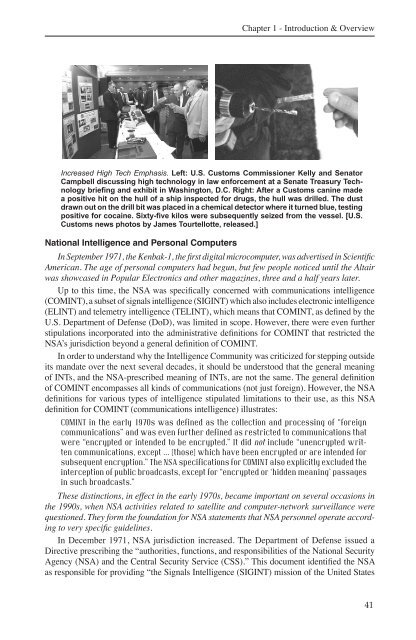Handbook of Surveillance Technologies (3rd Ed) - The Real Faces of ...
Handbook of Surveillance Technologies (3rd Ed) - The Real Faces of ...
Handbook of Surveillance Technologies (3rd Ed) - The Real Faces of ...
You also want an ePaper? Increase the reach of your titles
YUMPU automatically turns print PDFs into web optimized ePapers that Google loves.
Chapter 1 - Introduction & Overview<br />
Increased High Tech Emphasis. Left: U.S. Customs Commissioner Kelly and Senator<br />
Campbell discussing high technology in law enforcement at a Senate Treasury Technology<br />
briefing and exhibit in Washington, D.C. Right: After a Customs canine made<br />
a positive hit on the hull <strong>of</strong> a ship inspected for drugs, the hull was drilled. <strong>The</strong> dust<br />
drawn out on the drill bit was placed in a chemical detector where it turned blue, testing<br />
positive for cocaine. Sixty-five kilos were subsequently seized from the vessel. [U.S.<br />
Customs news photos by James Tourtellotte, released.]<br />
National Intelligence and Personal Computers<br />
In September 1971, the Kenbak-1, the first digital microcomputer, was advertised in Scientific<br />
American. <strong>The</strong> age <strong>of</strong> personal computers had begun, but few people noticed until the Altair<br />
was showcased in Popular Electronics and other magazines, three and a half years later.<br />
Up to this time, the NSA was specifically concerned with communications intelligence<br />
(COMINT), a subset <strong>of</strong> signals intelligence (SIGINT) which also includes electronic intelligence<br />
(ELINT) and telemetry intelligence (TELINT), which means that COMINT, as defined by the<br />
U.S. Department <strong>of</strong> Defense (DoD), was limited in scope. However, there were even further<br />
stipulations incorporated into the administrative definitions for COMINT that restricted the<br />
NSA’s jurisdiction beyond a general definition <strong>of</strong> COMINT.<br />
In order to understand why the Intelligence Community was criticized for stepping outside<br />
its mandate over the next several decades, it should be understood that the general meaning<br />
<strong>of</strong> INTs, and the NSA-prescribed meaning <strong>of</strong> INTs, are not the same. <strong>The</strong> general definition<br />
<strong>of</strong> COMINT encompasses all kinds <strong>of</strong> communications (not just foreign). However, the NSA<br />
definitions for various types <strong>of</strong> intelligence stipulated limitations to their use, as this NSA<br />
definition for COMINT (communications intelligence) illustrates:<br />
COMINT in the early 1970s was defined as the collection and processing <strong>of</strong> “foreign<br />
communications” and was even further defined as restricted to communications that<br />
were “encrypted or intended to be encrypted.” It did not include “unencrypted written<br />
communications, except ... [those] which have been encrypted or are intended for<br />
subsequent encryption.” <strong>The</strong> NSA specifications for COMINT also explicitly excluded the<br />
interception <strong>of</strong> public broadcasts, except for “encrypted or ‘hidden meaning’ passages<br />
in such broadcasts.”<br />
<strong>The</strong>se distinctions, in effect in the early 1970s, became important on several occasions in<br />
the 1990s, when NSA activities related to satellite and computer-network surveillance were<br />
questioned. <strong>The</strong>y form the foundation for NSA statements that NSA personnel operate according<br />
to very specific guidelines.<br />
In December 1971, NSA jurisdiction increased. <strong>The</strong> Department <strong>of</strong> Defense issued a<br />
Directive prescribing the “authorities, functions, and responsibilities <strong>of</strong> the National Security<br />
Agency (NSA) and the Central Security Service (CSS).” This document identified the NSA<br />
as responsible for providing “the Signals Intelligence (SIGINT) mission <strong>of</strong> the United States<br />
41



